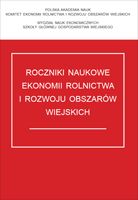Main Article Content
Article Details
Hamulczuk Mariusz, Cezary Klimkowski, Stanisław Stańko, 2103: Metody ilościowe w systemie prognozowania cen produktów rolnych, Program Wieloletni 2011-2014, nr 89, IERiGŻ-PIB, Warszawa, 25-26.
Hamulczuk Mariusz, Stańko Stanisław, 2009: Uwarunkowania prognozowania w agrobiznesie: teoria a decyzje gospodarcze, [w] Zarządzanie ryzykiem cenowym a możliwości stabilizowania dochodów producentów rolnych - aspekty poznawcze i aplikacyjne, red. Mariusz Hamulczuk, Stanisław Stańko, Program Wieloletni 2005-2009, nr 148, IERiGŻ-PIB, Warszawa, 138-178.
Jabłoński Konrad, Aldona Skarżyńska, Łukasz Abramczuk, 2015: Determinants of income from wheat and rape production in projection for 2020 in Poland, "Žemės Ūkio Mokslai", t. 22, nr 4, 229-239. (Crossref)
Kisielińska Joanna, 2012: Podstawy ekonometrii w Excelu, Wydawnictwo SGGW, Warszawa, 49.
Nowak Edward, 2009: Zaawansowana rachunkowość zarządcza, Wydanie 2, PWE, Warszawa, 63-72.
Sobczyk Mieczysław, 2008: Prognozowanie. Teoria, przykłady, zadania, Placet, Warszawa, 9-14.
Stańko Stanisław, 1999: Prognozowanie w rolnictwie, Wydanie 2, SGGW, Warszawa.
Stańko Stanisław, Mariusz Hamulczuk, 2013: Estymacja i weryfikacja modelu ekonometrycznego, [w] Prognozowanie w agrobiznesie. Teoria i przykłady zastosowania, red. Stanisław Stańko, Wydawnictwo SGGW, Warszawa, 73, 81.
Wasilewska Ewa, 2011: Statystyka opisowa od podstaw. Podręcznik z zadaniami, Wydawnictwo SGGW, Warszawa, 155-156.
Wojciechowska-Lipka Elżbieta, 2002: Ubezpieczenia majątkowe rolnictwa na świecie - wnioski dla Polski, [w] Ubezpieczenia gospodarcze. Wieś i rolnictwo, red. Mieczysław Adamowicz, Wydawnictwo SGGW, Warszawa, 48.
Zeliaś Aleksander, 1997: Teoria prognozy, Wydanie 3, PWE, Warszawa, 1-380.
Downloads
- Piotr Kułyk, Mariola Michałowska, CONDITIONS AND TRENDS IN FOOD CONSUMPTION IN LUBUSKIE VOIVODESHIP , Annals of Agricultural Economics and Rural Development: Vol. 104 No. 1 (2017)
You may also start an advanced similarity search for this article.
- Aldona Skarżyńska, THE SCALE OF AGRICULTURAL PRODUCTION ACTVITIES AND THEIR PROFITABILITY , Annals of Agricultural Economics and Rural Development: Vol. 98 No. 1 (2011)
- Aldona Skarżyńska, BEEF PRODUCTION AND DETERMINANTS ITS PROFITABILITY IN POLAND , Annals of Agricultural Economics and Rural Development: Vol. 104 No. 4 (2017)
- Aldona Skarżyńska, Economic cost for selected activities in crop production in the period 2005-2009 , Annals of Agricultural Economics and Rural Development: Vol. 97 No. 3 (2010)




